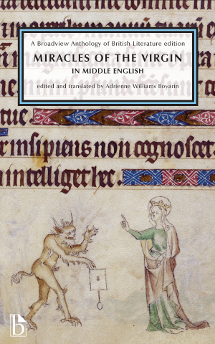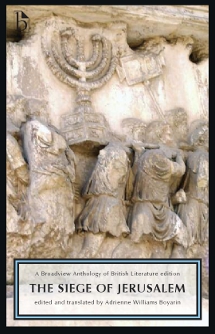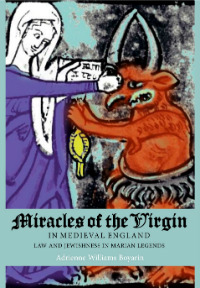Dr. Adrienne Williams Boyarin

Position
Contact
Credentials
BA and PhD (UC Berkeley)
Area of expertise
Medieval literature
Adrienne Williams Boyarin received her Ph.D. in English and Medieval Studies from the University of California, Berkeley in 2006 and joined the UVic faculty in the same year. She specializes in medieval English literature and culture. Her research and teaching focus on early Middle English, religion and literature, Christian-Jewish polemics, and writing about women (particularly holy women and Marian texts).
Courses taught for English and the Medieval Studies Program include: ENGL 147 (Intro. to Literary Traditions), ENGL 200A (English Lit. to 1660), ENGL 337 (Medieval British Lit. in Translation), ENGL 342 (Early Middle English), ENGL 472 (Gender Issues in Lit.: Gender and Sanctity in the Middle Ages), ENGL 500 (Intro. to Textual Studies and Research Methods), ENGL 515 (Chaucer), ENGL 515 (Writing Women in Medieval England), ENGL 516 (Anti-Jewish Discourse in Medieval England), MEDI 210 (Voices from the Middle Ages: The First Crusade), and MEDI 360 (Virgins and Whores: Female Bodies in Medieval Legend).
Selected book publications
Miracles of the Virgin in Middle English
 During the Middle Ages, Mary was the most powerful of saints, and the combination of her humanity and her proximity to the divine captured the medieval imagination. Her importance is nowhere more clearly reflected than in the genre of “Miracles of the Virgin,” short narrative accounts of Mary’s miraculous intercessory powers. These stories tend to fit a basic narrative pattern in which Mary saves a devoted believer from spiritual or physical danger—but beneath this surface simplicity, the Miracles frequently evoke fine or revealing theological, social, and cultural distinctions. They are remarkably various in tone, ranging from the darkly serious to the comically scandalous, and many display anti-Semitism to a greater degree or with greater punch than do other medieval genres. Mary herself takes on a variety of characteristics, appearing as dominant and persuasive more often than she appears as gentle and maternal.
During the Middle Ages, Mary was the most powerful of saints, and the combination of her humanity and her proximity to the divine captured the medieval imagination. Her importance is nowhere more clearly reflected than in the genre of “Miracles of the Virgin,” short narrative accounts of Mary’s miraculous intercessory powers. These stories tend to fit a basic narrative pattern in which Mary saves a devoted believer from spiritual or physical danger—but beneath this surface simplicity, the Miracles frequently evoke fine or revealing theological, social, and cultural distinctions. They are remarkably various in tone, ranging from the darkly serious to the comically scandalous, and many display anti-Semitism to a greater degree or with greater punch than do other medieval genres. Mary herself takes on a variety of characteristics, appearing as dominant and persuasive more often than she appears as gentle and maternal.
The Siege of Jerusalem

Broadview, 2013
An annotated Modern English verse translation of the violent and unsettling Middle English alliterative poem. Includes novice-friendly introduction and appendices with contextual primary sources.
Miracles of the Virgin in Medieval England: Law and Jewishness in Marian Legends

D.S. Brewer, 2010
Legendary accounts of the Virgin Mary's intercession were widely circulated throughout the Middle Ages and borrowed heavily, as hagiography generally, from folktale and other literary motifs. Mary is represented in these texts in a number of different ways, rarely as the meek and mild mother of Christ, but often as a bookish, fierce, and capricious advocate.
This is the first book-length study of the place of medieval Miracles of the Virgin in a specifically English literary and cultural history. While the English circulation of vernacular Marian legends was markedly different from continental examples, this book shows how difference and miscellaneity can reveal important developments within an unwieldy genre. Boyarin argues that English miracles in particular were influenced by medieval England's troubled history with its Jewish population and the rapid thirteenth-century codification of English law, so that Mary frequently becomes a figure with special dominion over Jews, text, and legal problems. The shifting codicological and historical contexts of these texts make clear that the paradoxical sign 'Mary' could signify in surprisingly different and surprisingly consistent ways, rendering Mary both mediatrix and legislatrix.
Selected journal publications
"This is No Museum." "Acknowledged Convictions" and Ongoing Conversation: A Forum in Response to Religion & Literature 42.1-2. Ed. Katy Wright-Bushman and Robert Kirkpatrick, in Religion and Literature 44.3 (2012): 226-239.
"Inscribed Bodies: The Virgin Mary, Jewish Women, and Medieval Feminine Legal Authority." Law and Sovereignty in the Middle Ages and Renaissance. Arizona Studies in the Middle Ages and Renaissance 28. Ed. Robert S. Sturges. Turhout: Brepols, 2011. 229-51.
"Desire for Religion: Mary, a Murder Libel, a Jewish Friar, and Me." "Something Fearful": Medievalist Scholars on the Religious Turn in Literary Criticism. Ed. Kathryn Kerby-Fulton. Spec. iss. of Religion and Literature 42.1-2 (2010): 23-48. (with response by Daniel Boyarin)
"Sealed Flesh, Book-Skin: How to Read the Female Body in the Early Middle English Seinte Margarete." Women and the Divine in Literature before 1700: Essays in Memory of Margot Louis. Ed. Kathryn Kerby-Fulton. Victoria: ELS, 2009. 87-106.
"Anti-Jewish Parody around Miracles of the Virgin?: Thoughts on an Early Nonsense-Cento in Berkeley, Bancroft Library, MS UCB 92." Notes & Queries. 54.4 (2007): 379-85.
"Competing Biblical and Virgilian Allusions in Wyatt's 'Who so list to hount.'" Notes & Queries. 53.4 (2006): 417-21.
